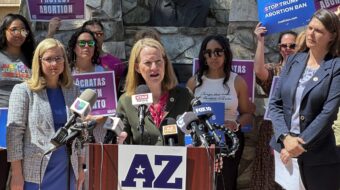
WASHINGTON (PAI) — What does it mean to have a constitutional right?
The U.S. Supreme Court addressed that question on March 2 when it heard arguments about a Texas law that so strictly regulates clinics that perform abortions as to drive most of them out of business.
The court’s decision in Whole Woman’s Health v. Hellerstedt could have implications for all constitutional rights, not just abortion. If Texas, on grounds as flimsy as it offered in Whole Woman’s Health, can make it nearly impossible for women to exercise their constitutional right to abortion, what other constitutional rights can government burden without justification?
In Roe v. Wade in 1973, the court overturned an earlier Texas law and recognized a constitutional right to abortion. Traditionally, the court has rejected government attempts to burden a constitutional right just to discourage people from exercising it.
For example, if you work for the government, your boss can’t fire you just because you vote for candidates the boss opposes. Under the U.S. Constitution, you have the right to your own politics, whether or not some government official approves.
Even when the government has a legitimate reason to burden a constitutional right, usually the government can burden that right only to further a hugely important government interest, without needlessly burdening the constitutional right.
For example, though stopping violence qualifies as sufficiently important, and though a provocative speaker might incite a violent reaction, courts usually find the government has other ways-besides silencing the speaker-of preventing violence. If the government has other ways to prevent violence, without suppressing speech, it must use them.
In 2013, Texas passed a law requiring every clinic that performs abortions to comply with the stringent standards for outpatient surgical centers. The 2013 law also requires every clinic doctor who performs an abortion to have hospital admitting privileges within 30 miles of the clinic.
After the law passed, half Texas’s reproductive-health clinics closed. Another half will close if the Supreme Court upholds the law. In the entire state-America’s second largest geographically and in population-only nine clinics will survive, all in metropolitan areas. A quarter of Texas women will live more than 100 miles from the nearest clinic. In the Rio Grande Valley, women will have to travel nearly four hours to reach a clinic.
Anti-abortion forces have used similar tactics across the country. Eight other states subject clinic doctors to an admitting-privileges requirement. Twenty other states impose surgical-center standards on clinics that perform abortions-even though an increasing number of abortions don’t require surgery. In part because of these restrictions, 89 percent of all American counties, home to nearly 40 percent of American women, have no clinics that perform abortions.
Abortion is one of the safest medical procedures. The Texas law does not apply to far more dangerous procedures. Indeed, doctors use one type of surgery sometimes to induce an abortion, sometimes for other purposes. The law applies only when the purpose is abortion.
Moreover, by causing some women to delay an abortion, and other women to attempt a self-induced abortion, the Texas law will actually endanger women’s heath, according to the American Medical Association and the American College of Obstetricians and Gynecologists.
This is not just a war on abortion. It’s a war on women, and against the U.S. Constitution.
In 1992, in a case from Pennsylvania, the Supreme Court ruled an abortion regulation violates the Constitution if it has the purpose or effect of placing a “substantial obstacle” or “undue burden” in the path of women seeking an abortion.
Regarding the Texas law’s purpose, at the March 2 argument Justice Elena Kagan asked why Texas, purportedly to protect women, would single out abortion clinics for regulations that actually increase the danger to women. Texas Solicitor General Scott Keller could only refer vaguely to possible abortion “complications.” He could not identify one Texan who, because of inadequacies in prior law, had suffered health complications from an abortion.
Even Justice Anthony Kennedy noted that the Texas law “may not be medically wise.”
In a friend-of-the-court brief, the National Association of Social Workers argues the court should interpret the Texas law as designed solely to discourage abortion, not to help women. However, if one credits the Texas legislature with a good-faith interest in women’s health, the case then turns on whether the “undue burden” test requires the justices to decide if the Texas law actually promotes women’s health.
Arguing against the Texas law, U.S. Solicitor General Donald Verrilli pointed out the common understanding of the word “undue” includes whether something is “excessive or unwarranted.” He added that without a judicial examination of the law’s actual effect on women’s health, the right recognized in Roe v. Wade would no longer have “real substance.”
Following the pattern of recent years, Justice Kennedy’s views will determine the outcome. If Kennedy votes to sustain the Texas law, the eight-member court will probably deadlock, and a court of appeals decision upholding the Texas law will stand for the two states, Texas and Louisiana, that that appeals court covers.
The Supreme Court’s decision is expected in late June.
David Sobelsohn is PAI Supreme Court Correspondent.
Photo: Whole Woman’s Health Fight Back Texas Truth Tour, Facebook.












Comments